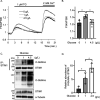Fluctuation in O-GlcNAcylation inactivates STIM1 to reduce store-operated calcium ion entry via down-regulation of Ser621 phosphorylation
- PMID: 33023909
- PMCID: PMC7863906
- DOI: 10.1074/jbc.RA120.014271
Fluctuation in O-GlcNAcylation inactivates STIM1 to reduce store-operated calcium ion entry via down-regulation of Ser621 phosphorylation
Abstract
Stromal interaction molecule 1 (STIM1) plays a pivotal role in store-operated Ca2+ entry (SOCE), an essential mechanism in cellular calcium signaling and in maintaining cellular calcium balance. Because O-GlcNAcylation plays pivotal roles in various cellular function, we examined the effect of fluctuation in STIM1 O-GlcNAcylation on SOCE activity. We found that both increase and decrease in STIM1 O-GlcNAcylation impaired SOCE activity. To determine the molecular basis, we established STIM1-knockout HEK293 (STIM1-KO-HEK) cells using the CRISPR/Cas9 system and transfected STIM1 WT (STIM1-KO-WT-HEK), S621A (STIM1-KO-S621A-HEK), or T626A (STIM1-KO-T626A-HEK) cells. Using these cells, we examined the possible O-GlcNAcylation sites of STIM1 to determine whether the sites were O-GlcNAcylated. Co-immunoprecipitation analysis revealed that Ser621 and Thr626 were O-GlcNAcylated and that Thr626 was O-GlcNAcylated in the steady state but Ser621 was not. The SOCE activity in STIM1-KO-S621A-HEK and STIM1-KO-T626A-HEK cells was lower than that in STIM1-KO-WT-HEK cells because of reduced phosphorylation at Ser621 Treatment with the O-GlcNAcase inhibitor Thiamet G or O-GlcNAc transferase (OGT) transfection, which increases O-GlcNAcylation, reduced SOCE activity, whereas treatment with the OGT inhibitor ST045849 or siOGT transfection, which decreases O-GlcNAcylation, also reduced SOCE activity. Decrease in SOCE activity due to increase and decrease in O-GlcNAcylation was attributable to reduced phosphorylation at Ser621 These data suggest that both decrease in O-GlcNAcylation at Thr626 and increase in O-GlcNAcylation at Ser621 in STIM1 lead to impairment of SOCE activity through decrease in Ser621 phosphorylation. Targeting STIM1 O-GlcNAcylation could provide a promising treatment option for the related diseases, such as neurodegenerative diseases.
Keywords: O-GlcNAcylation; O-linked N-acetylglucosamine (O-GlcNAc) transferase (OGT); calcium; phosphorylation; protein phosphorylation; store-operated Ca2+ entry; store-operated calcium entry (SOCE); stromal interaction molecule 1 (STIM1).
© 2020 Nomura et al.
Conflict of interest statement
Conflict of interest—The authors declare that they have no conflicts of interest with the contents of this article.
Figures








Similar articles
-
Filamin A Modulates Store-Operated Ca2+ Entry by Regulating STIM1 (Stromal Interaction Molecule 1)-Orai1 Association in Human Platelets.Arterioscler Thromb Vasc Biol. 2018 Feb;38(2):386-397. doi: 10.1161/ATVBAHA.117.310139. Epub 2017 Dec 28. Arterioscler Thromb Vasc Biol. 2018. PMID: 29284605
-
Modification of STIM1 by O-linked N-acetylglucosamine (O-GlcNAc) attenuates store-operated calcium entry in neonatal cardiomyocytes.J Biol Chem. 2012 Nov 9;287(46):39094-106. doi: 10.1074/jbc.M112.383778. Epub 2012 Sep 19. J Biol Chem. 2012. PMID: 22992728 Free PMC article.
-
Interplay between ER Ca2+ Binding Proteins, STIM1 and STIM2, Is Required for Store-Operated Ca2+ Entry.Int J Mol Sci. 2018 May 19;19(5):1522. doi: 10.3390/ijms19051522. Int J Mol Sci. 2018. PMID: 29783744 Free PMC article.
-
SOCE and STIM1 signaling in the heart: Timing and location matter.Cell Calcium. 2019 Jan;77:20-28. doi: 10.1016/j.ceca.2018.11.008. Epub 2018 Nov 27. Cell Calcium. 2019. PMID: 30508734 Free PMC article. Review.
-
The roles and mechanism of STIM1 in tumorigenesis and metastasis.Yi Chuan. 2023 May 20;45(5):395-408. doi: 10.16288/j.yczz.23-035. Yi Chuan. 2023. PMID: 37194587 Review.
Cited by
-
Enhanced Orai1-mediated store-operated Ca2+ channel/calpain signaling contributes to high glucose-induced podocyte injury.J Biol Chem. 2022 Jun;298(6):101990. doi: 10.1016/j.jbc.2022.101990. Epub 2022 Apr 29. J Biol Chem. 2022. PMID: 35490782 Free PMC article.
-
ORAI1 establishes resistance to SARS-CoV-2 infection by regulating tonic type I interferon signaling.bioRxiv [Preprint]. 2021 May 4:2021.05.04.442548. doi: 10.1101/2021.05.04.442548. bioRxiv. 2021. Update in: J Immunol. 2022 Jan 1;208(1):74-84. doi: 10.4049/jimmunol.2100742. PMID: 33972946 Free PMC article. Updated. Preprint.
-
Control of STIM and Orai function by post-translational modifications.Cell Calcium. 2022 May;103:102544. doi: 10.1016/j.ceca.2022.102544. Epub 2022 Jan 31. Cell Calcium. 2022. PMID: 35151050 Free PMC article. Review.
-
ORAI1 Limits SARS-CoV-2 Infection by Regulating Tonic Type I IFN Signaling.J Immunol. 2022 Jan 1;208(1):74-84. doi: 10.4049/jimmunol.2100742. Epub 2021 Nov 24. J Immunol. 2022. PMID: 34819389 Free PMC article.
-
Tacrolimus Improves Therapeutic Efficacy of Umbilical Cord Blood-Derived Mesenchymal Stem Cells in Diabetic Retinopathy by Suppressing DRP1-Mediated Mitochondrial Fission.Antioxidants (Basel). 2023 Sep 6;12(9):1727. doi: 10.3390/antiox12091727. Antioxidants (Basel). 2023. PMID: 37760030 Free PMC article.
References
-
- Holt, G. D., Haltiwanger, R. S., Torres, C. R., and Hart, G. W. (1987) Erythrocytes contain cytoplasmic glycoproteins: O-linked GlcNAc on Band 4.1. J. Biol. Chem. 262, 14847–14850 - PubMed
Publication types
MeSH terms
Substances
LinkOut - more resources
Full Text Sources
Molecular Biology Databases
Research Materials
Miscellaneous

